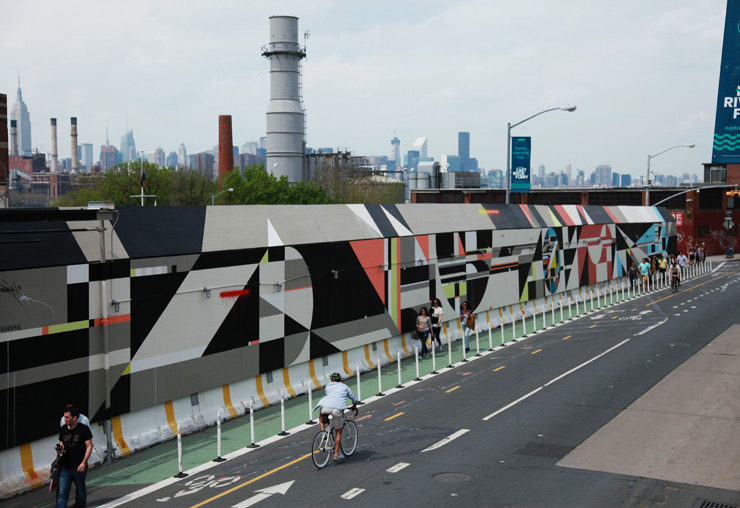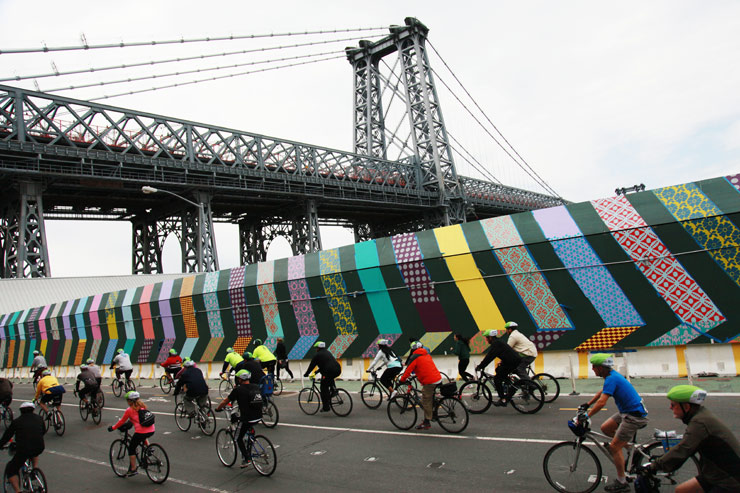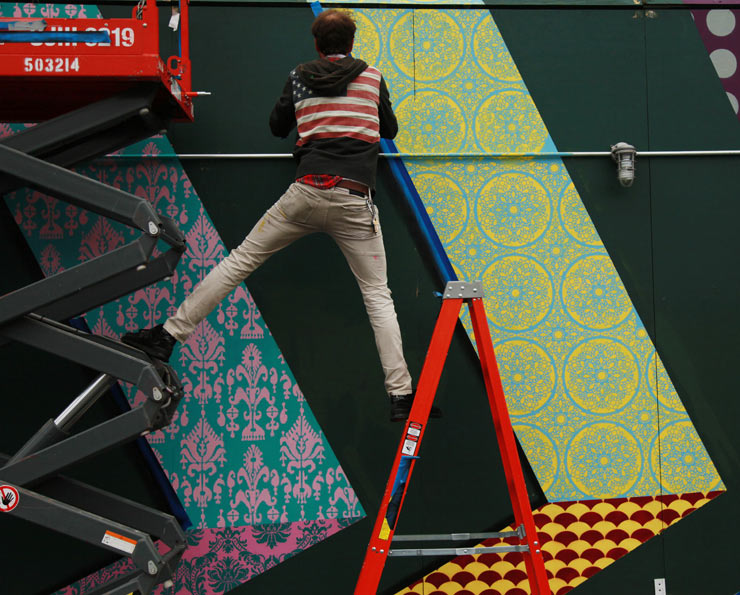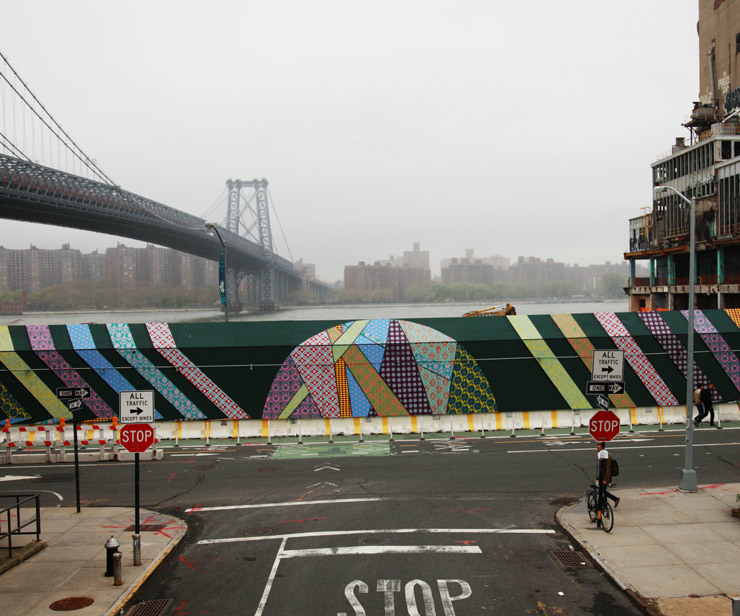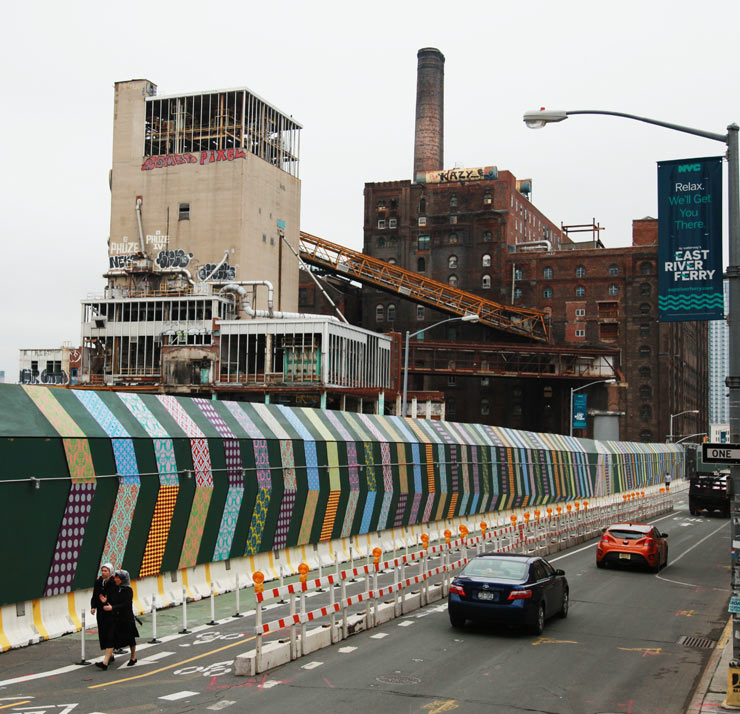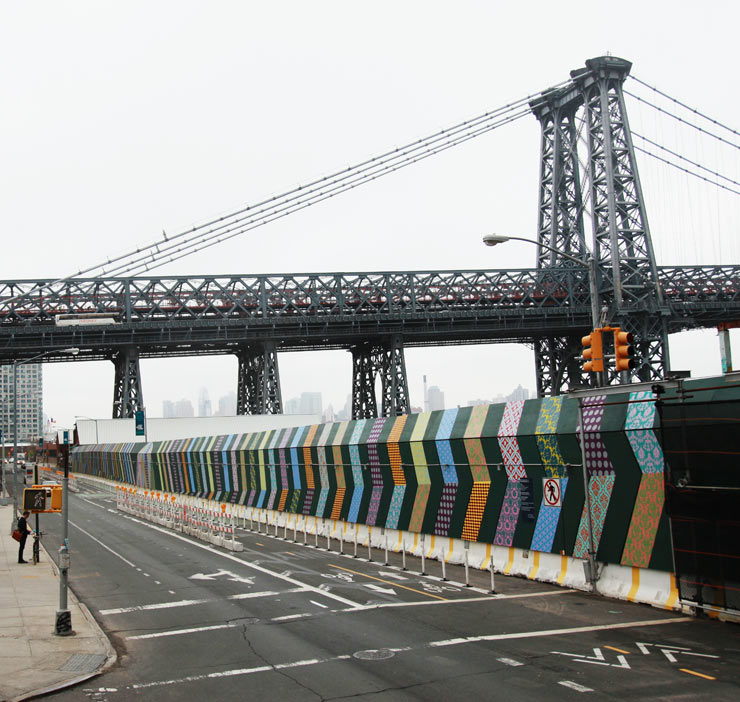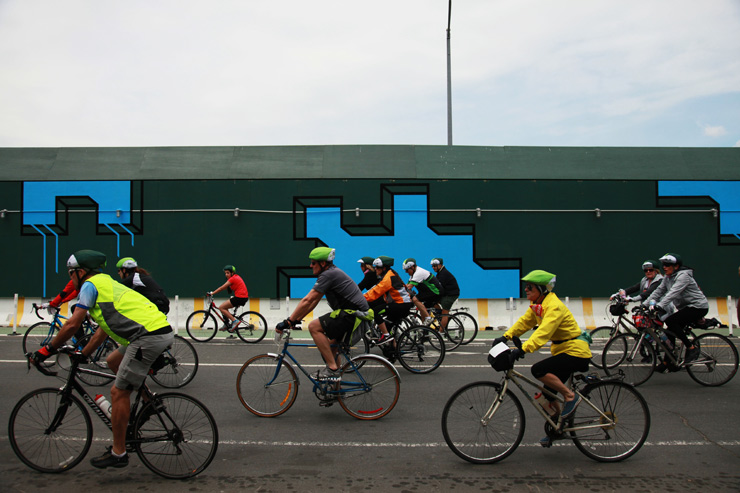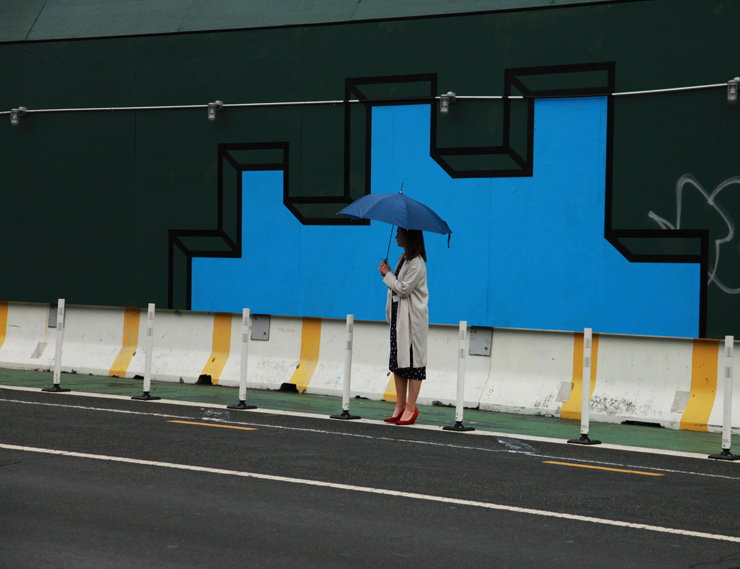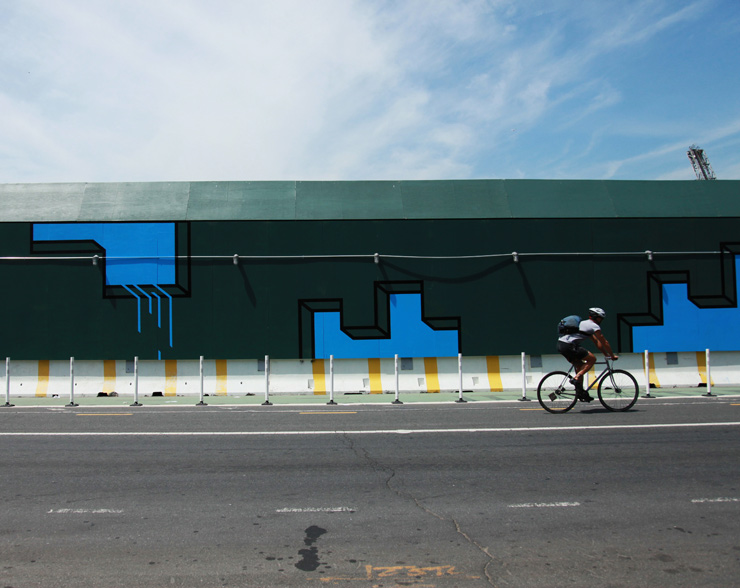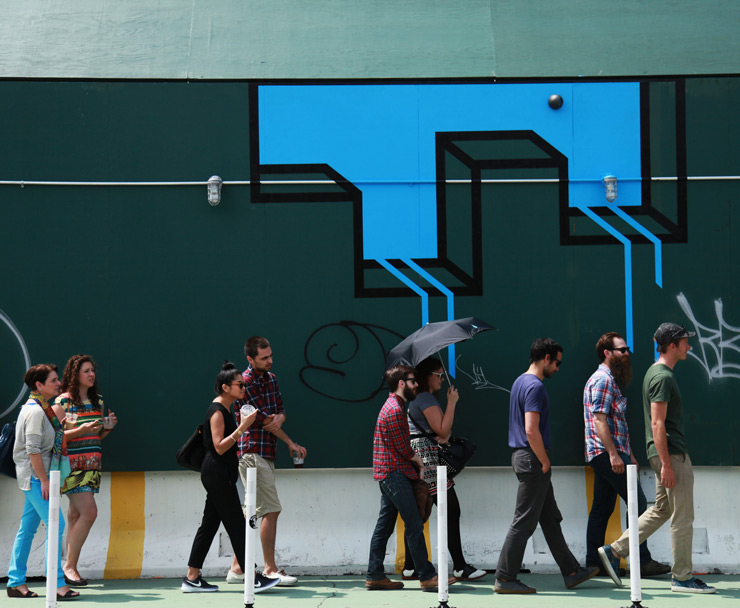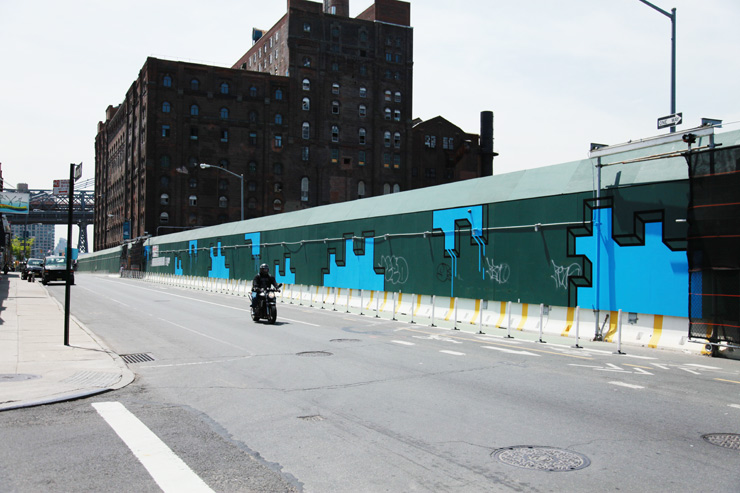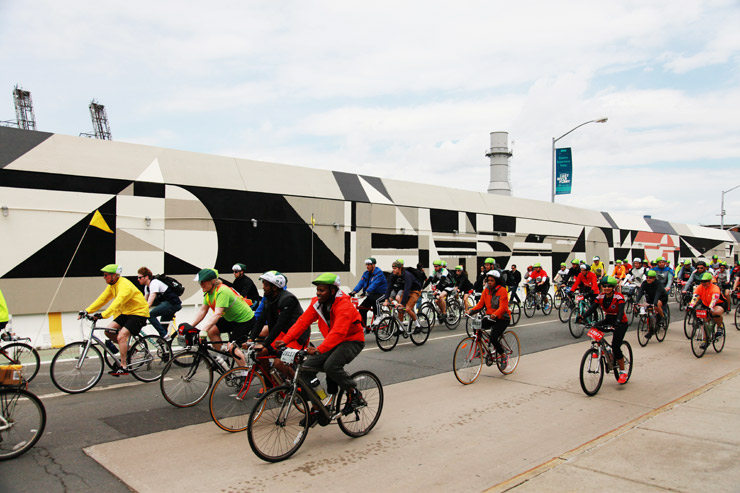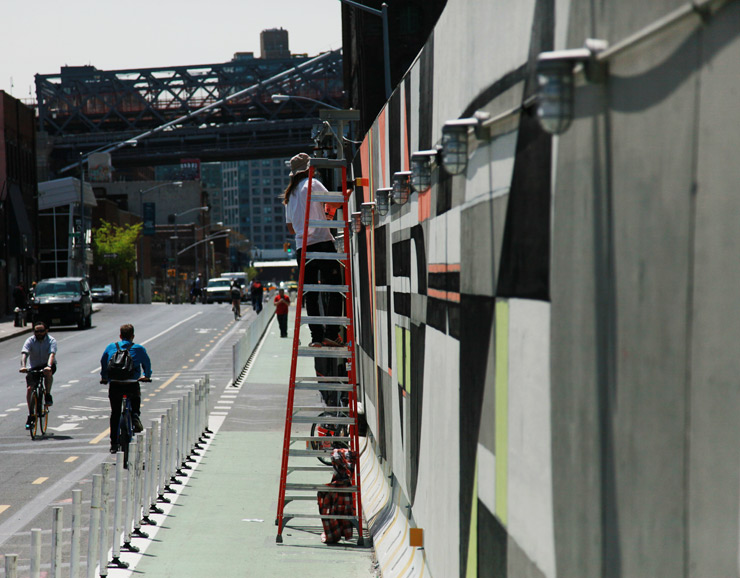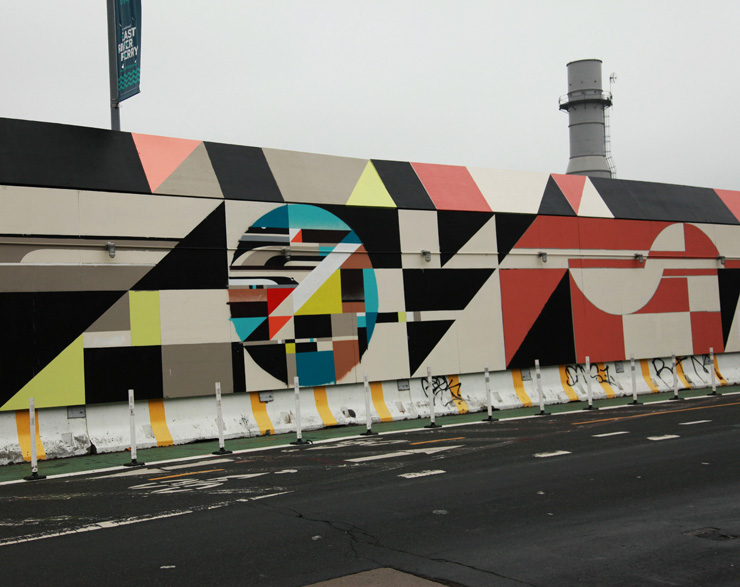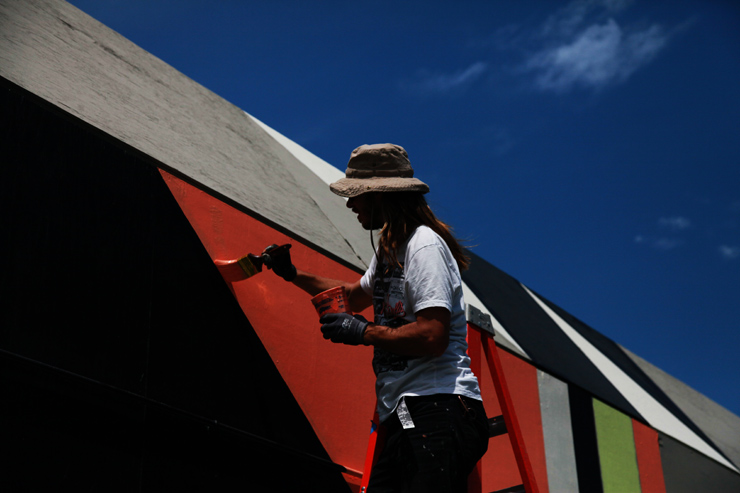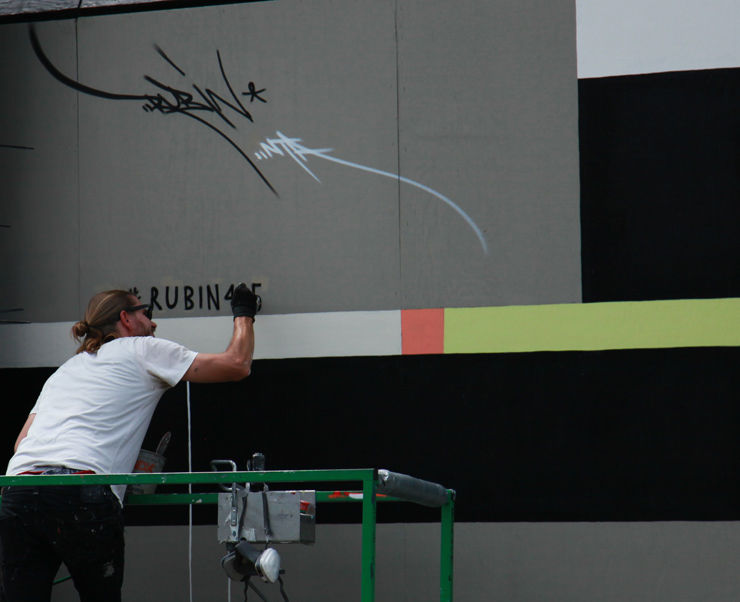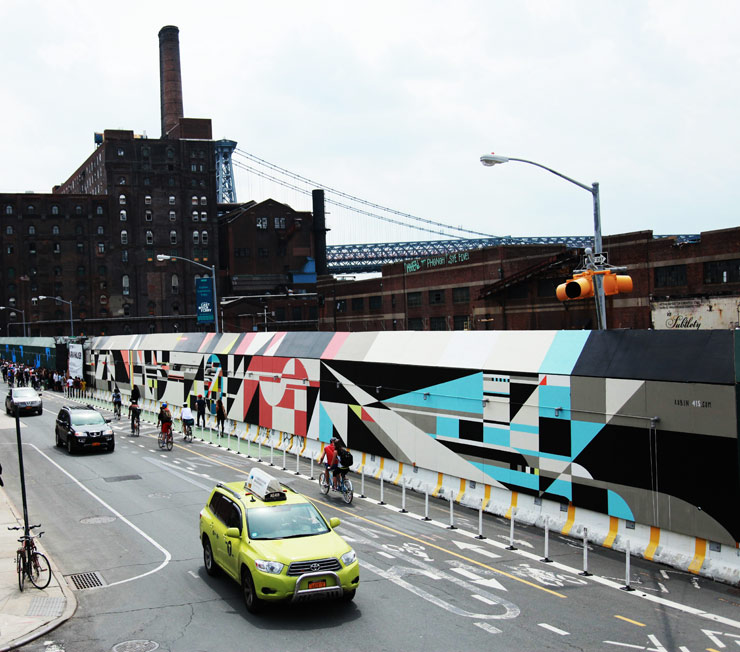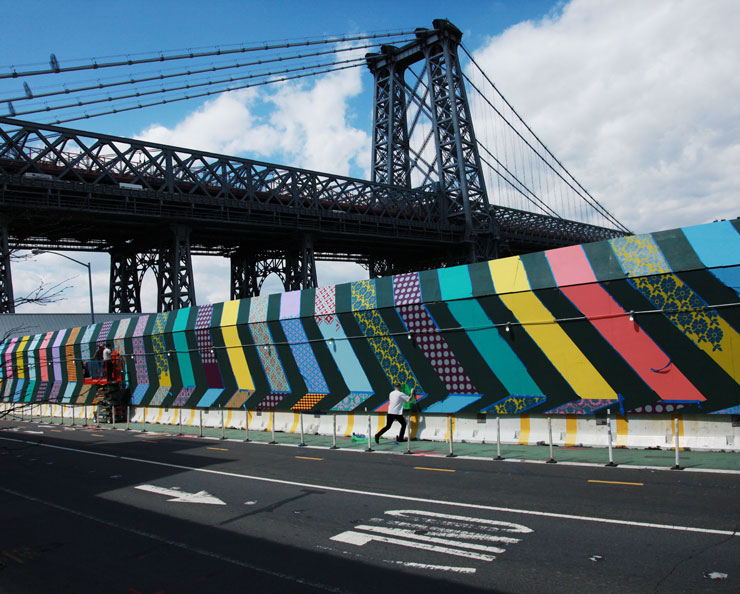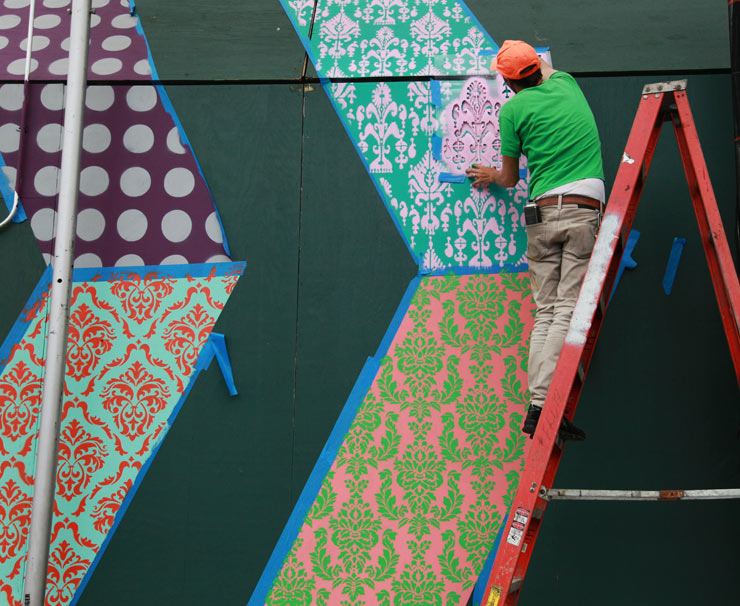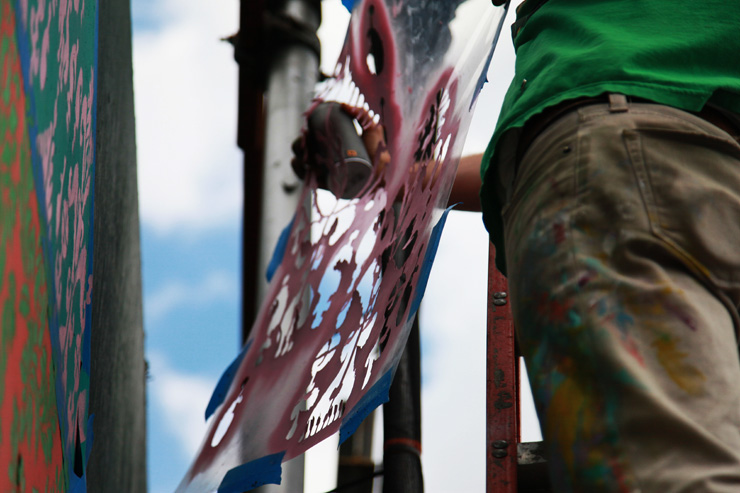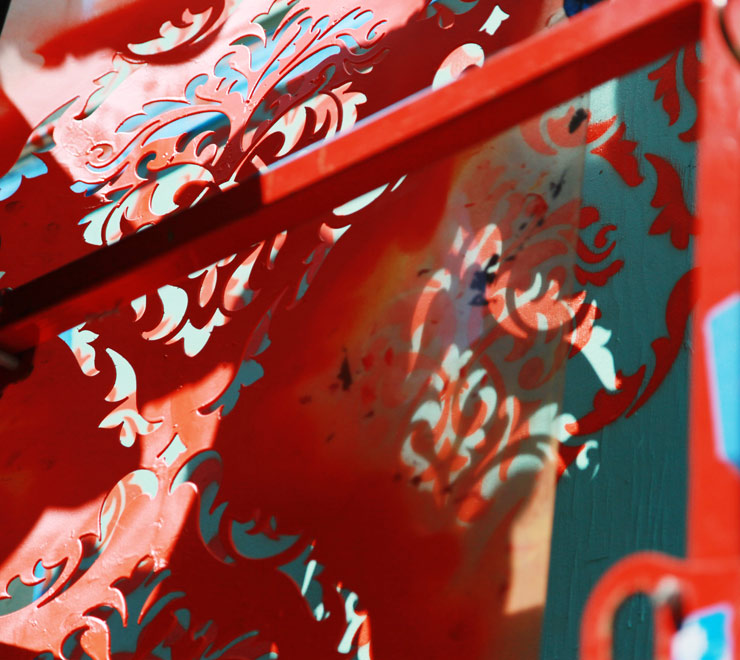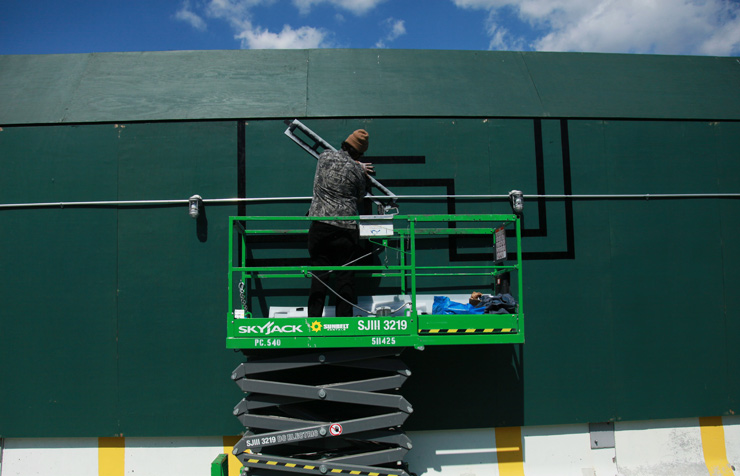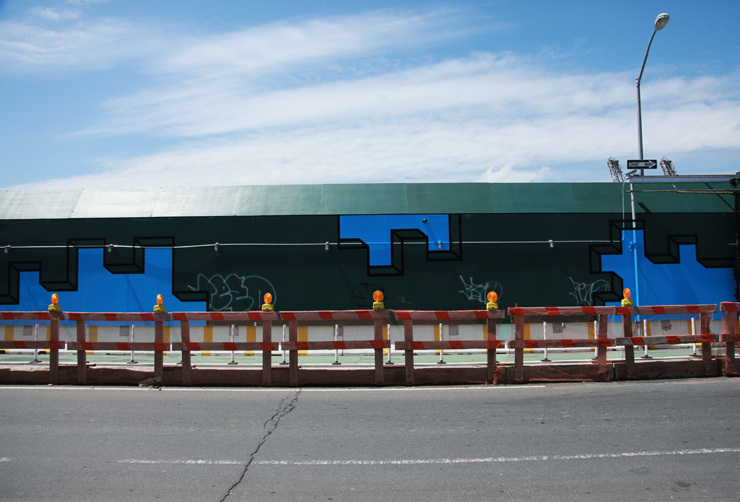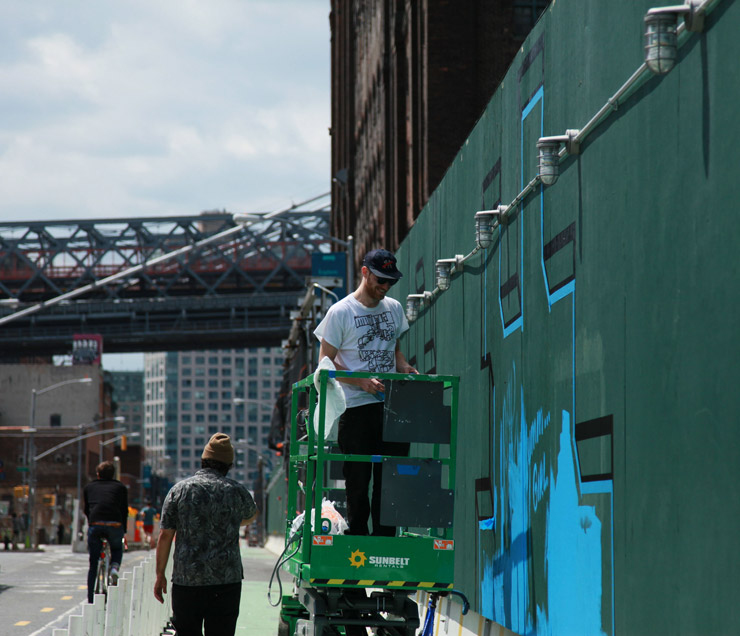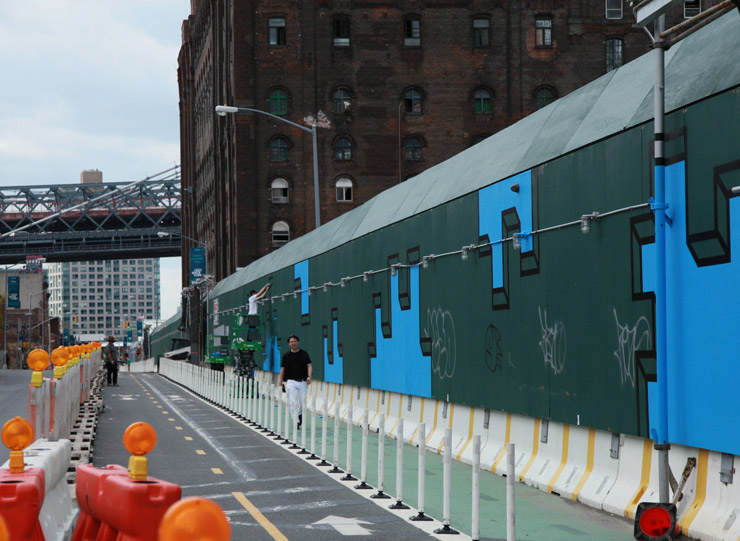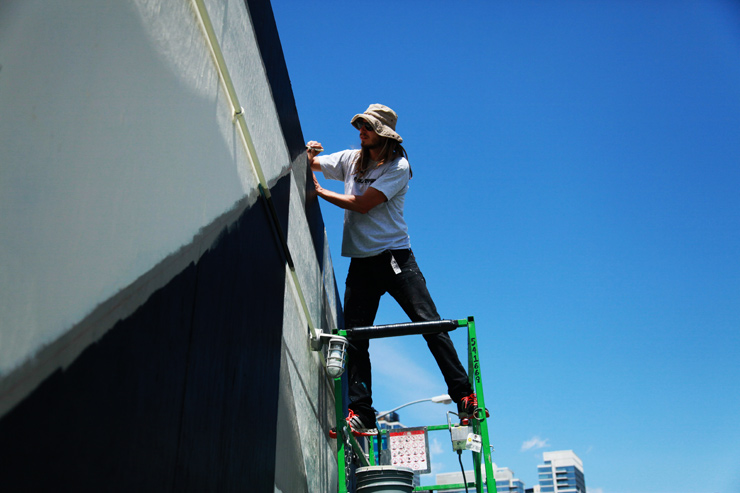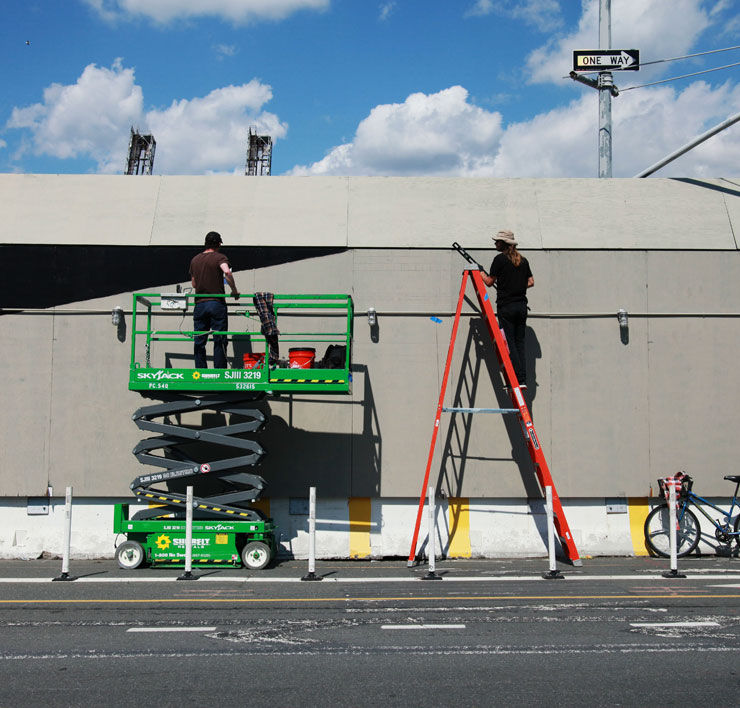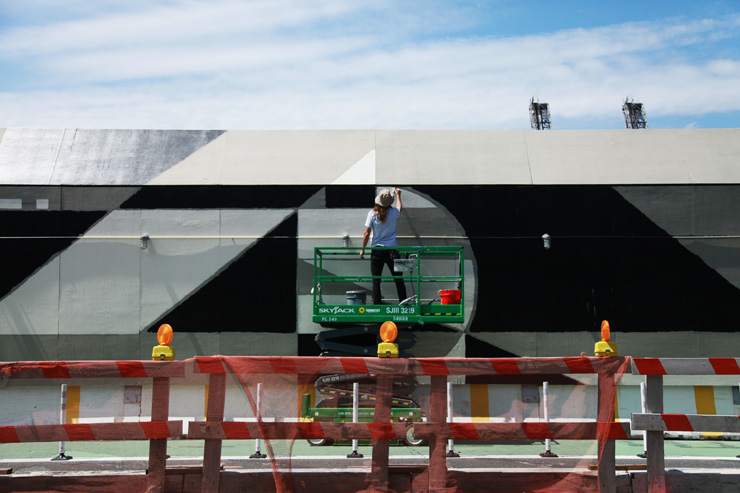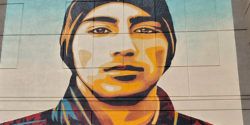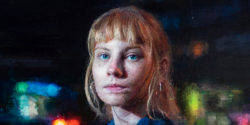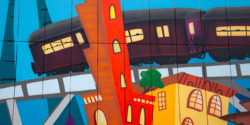“Done!” comes the text from Rubin, who is floating on his scissor lift six feet above the line of people down Kent Avenue that is cued along Aakash Nihalani’s new wall for the public opening of Kara Walker’s exhibit in the Domino factory warehouse.
Swear to the Sugar Gods: Not 10 minutes later “Done” arrives again on our phone screens, this time from Hellbent, signaling that his ginormous 476 foot mural is complete as well – three weeks, several rainstorms, and a five borough bike tour elapsing since he and his team started.
Hellbent. Process shot taken during the Five-Borough Bike tour. (photo © Jaime Rojo)
Our Domino Walls project hit this finish line this weekend, and although there is at least one more wall to be revealed a little later in this phase, we thought we’d get these shots out to BSA readers so you’d have closure on our progress post last week.
It’s been a dope project and each one of the artists has told us some good information about the thinking and inspiration behind their pieces, their links to geometric forms and futurism – so we’ll share some of that for you too. Also we want to give a shout out to the Walentas family, who funded this project and who we’ve known since we worked as artists, volunteers, fundraisers, exhibitors in DUMBO during the 90s and 00s. They have always provided platforms for creative types to get their stuff out there into the community. Here’s another.
Hellbent. Process shot. (photo © Jaime Rojo)
“I like how you can trick the eye using geometric shapes, shadows, and patterns and color in my newer paintings. I think what Poesia has been talking about and organizing around with Graffuturism is something that I feel aligned with in street work and mural work and in the urban contemporary setting. It is a kind of return to abstract art. Graff has gone through lettering, to characters, to pictoral, and now we are coming into abstraction and that’s the stuff that I’m into right now,” says Hellbent.
“So I’m seeing a lot of work that is coming out of eastern Europe, in Poland, and a scattering of these guys in America and central Europe and it is work that I’m drawn to and influenced by. I think Graffuturism is a kind of good term for what is going on right now – it’s a subset of all these other different things that are going on in the streets.”
Hellbent. (photo © Jaime Rojo)
Brooklyn Street Art: Can you tell us anything about the neighbors taking great interest in the paintings. We’ve heard you have some new fans.
Hellbent: Yes, I’m really happy to say that the Hasidic community has been really behind what’s going on here. I’ve had some really great conversations with them while we’ve been painting. It’s been really nice to hear that and I like to see my audience broadening a bit like that. I think a lot of people are just happy to see something besides this green wall, actually.
Hellbent. Tools of the trade. (photo © Jaime Rojo)
Hellbent. Detail. (photo © Jaime Rojo)
Hellbent. North View. (photo © Jaime Rojo)
Hellbent. North view. (photo © Jaime Rojo)
Hellbent. South view. (photo © Jaime Rojo)
Aakash Nihalani. Shot taken during the Five-Borough Bike tour. (photo © Jaime Rojo)
Aakash Nihalani. Detail. (photo © Jaime Rojo)
Brooklyn Street Art: You’ve always been interested in sort of pulling geometry out of spaces and revealing it. Is that right?
Aakash Nihalani: Kind of. I mean I think more often than not it is highlighting the space that is already there. So it’s not necessarily creating a new space its more about highlighting the space that already exists, I guess.
Brooklyn Street Art: As you have gone bigger, has it been a difficult transition?
Aakash Nihalani: I wouldn’t say difficult, but I work with tape and I don’t work with paint and this is all paint, so in that sense it is out of my medium realm. Having tried spray paint now – I’m really not interested in murals and painting. Yeah, I definitely prefer tape over paint for sure.
Aakash Nihalani. Detail. (photo © Jaime Rojo)
Brooklyn Street Art: I would think so – when I’ve seen you working with it (tape) it just seems to flow out of your thumb.
Aakash Nihalani: Yeah.
Brooklyn Street Art: So it feels like you are “painting” with tape.
Aakash Nihalani: Yeah exactly. I mean this is too, it’s fun. It’s a good challenge to try to figure out a process that fits and will work for the clean lines that I’m going for.
Brooklyn Street Art: Do you think of this as a mural?
Aakash Nihalani: I don’t think so. I don’t know what I would call it. I would say it is still an installation.
The long lines for Kara Walker past Aakash Nihalani. Detail. (photo © Jaime Rojo)
Aakash Nihalani (photo © Jaime Rojo)
Rubin. Shot taken during the Five-Borough Bike tour. (photo © Jaime Rojo)
Rubin at work on his wall. (photo © Jaime Rojo)
Rubin. Detail. (photo © Jaime Rojo)
Rubin: I try not to look back but in the mid-nineties I was one of the most active writers in Sweden and I have my photo collection with me here and I’ve been working on it for years, trying to scan the images and I realize that a lot of the stuff I’m doing now, without really thinking and knowing it, started in the mid nineties. So I did a lot of abstract. The geometrics has always been there, the craftsmanship – being able to do straight lines, – a lot of the stuff. So I like to sample myself I guess. I also try to think of it in terms of music a lot.
Brooklyn Street Art: Really? What music is influencing this wall?
Rubin: It may sound weird but two of my influences have been Kraftwerk, which may seem obvious, but also Nina Simone. I’ve been listening to her music a lot. I’ve been listening to her while creating a lot of my sketches.
Rubin at work on his wall. (photo © Jaime Rojo)
Brooklyn Street Art: It makes a lot of sense. The composition of the whole wall is like a music diagram.
Rubin: Like the rhythm in a piece, it has to start with the intro, getting into the verse, then in the middle it gets busy with the chorus, then you get a bridge, the song gets to breathe a little bit, and then you have the outtro so its all the same between music and art. It’s different tools to express – some ideas work better as paint and some as audio.
Brooklyn Street Art: I can see Kraftwerk in this epic minimalist cleanly structured classical approach – so that is the overall sweep, and the scale. But in addition there are the more organic forms, the color, warmth, the gentleness and strength – that part comes from Nina Simone?
Rubin: Yeah and the melancholy, her lyrics – she dealt with a lot of hard stuff and yeah, she has affected me a lot.
Rubin’s epic mural effectively mimicing the city view on both sides of the East River. North View. (photo © Jaime Rojo)
Brooklyn Street Art: So it is like you’ve been discovering your own past.
Rubin: Yeah, and it also relates to when I started deconstructing my work
Brooklyn Street Art: When you were doing graffiti?
Rubin: Yeah, and then moving to working more large scale I had to adapt my work so that I can still work fast. It suits me so well. It is also is about balance, it can’t be too geometric so it’s always a struggle so that is why I try to keep my work free hand – so I don’t use projectors and stencils. I started using the chalk line more because it’s a time saver, but also I try to keep it analog and organic and physical. It can’t be too sharp – there has to be a more human element.
Rubin (photo © Jaime Rojo)
Brooklyn Street Art: Yes, well you have some more organic forms in this also.
Rubin: Yeah but at the same time there is no right or wrong so you have to be true to yourself, whatever feels right for you.
Brooklyn Street Art: Did you like the Italian Futurists show at the Guggenheim?
Rubin: Yeah! I was very very emotional. It was very overwhelming. There was also another side of it, a political aspect, that was very radical.
Rubin. A southern view as visitors to the Kara Walker exhibit “Subtlety” cut in just before his wall begins . (photo © Jaime Rojo)
Domino Walls is a project supported by Two Trees Management, the firm that is developing the Domino Sugar Factory site, and under the guidance of Lisa Kim, Cultural Affairs Director. BSA is acting as the curatorial advisor on this project.
Read Part I of this posting here:
Hellbent, Rubin, and Aakash Nihalani In Progress on Domino Walls in BK
<<>>><><<>BSA<<>>><<<>><><BSA<<>>><><<>BSA<<>>><<<>><><BSA
Please note: All content including images and text are © BrooklynStreetArt.com, unless otherwise noted. We like sharing BSA content for non-commercial purposes as long as you credit the photographer(s) and BSA, include a link to the original article URL and do not remove the photographer’s name from the .jpg file. Otherwise, please refrain from re-posting. Thanks!
<<>>><><<>BSA<<>>><<<>><><BSA<<>>><><<>BSA<<>>><<<>><><BSA
 BROOKLYN STREET ART LOVES YOU MORE EVERY DAY
BROOKLYN STREET ART LOVES YOU MORE EVERY DAY